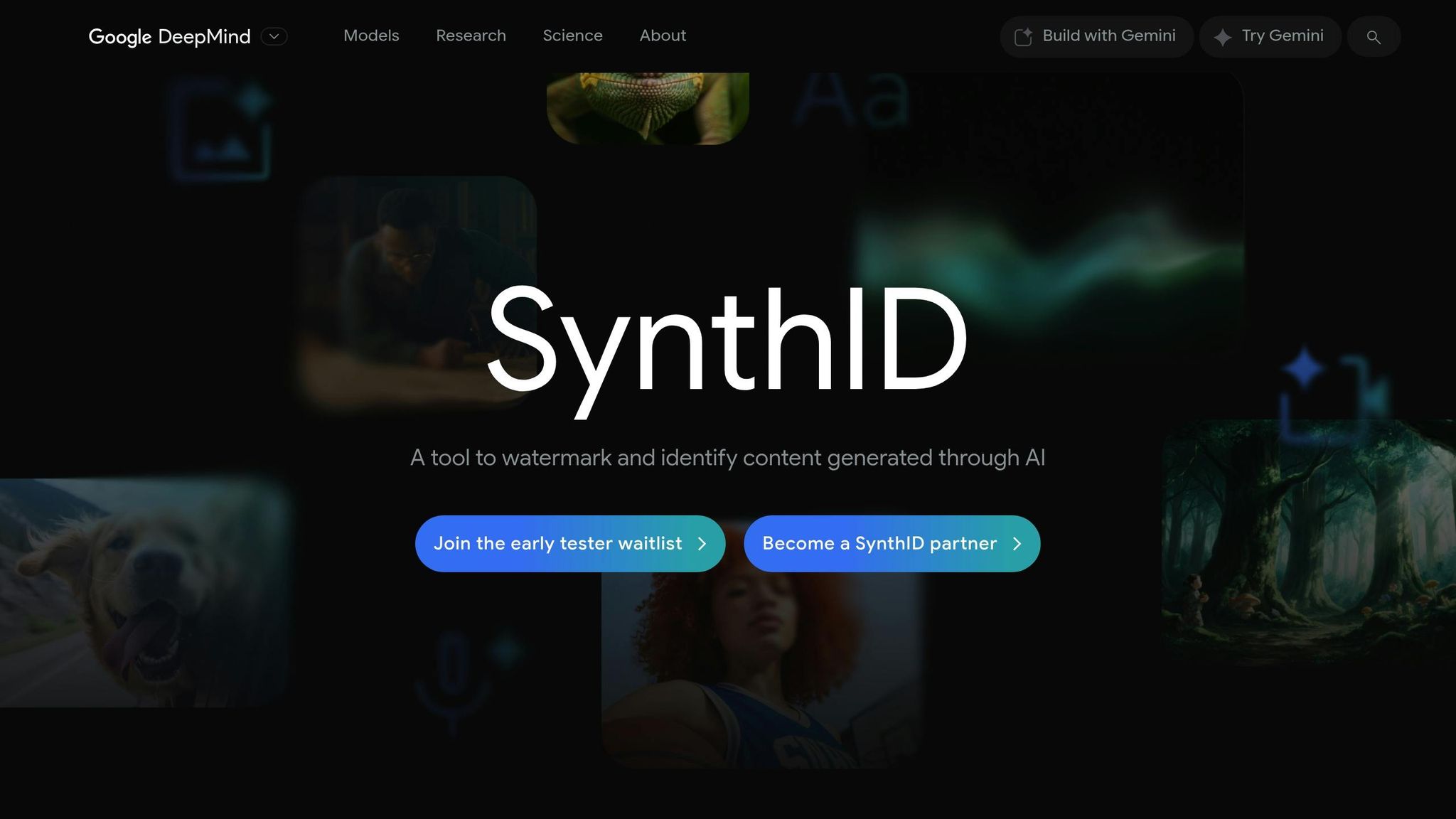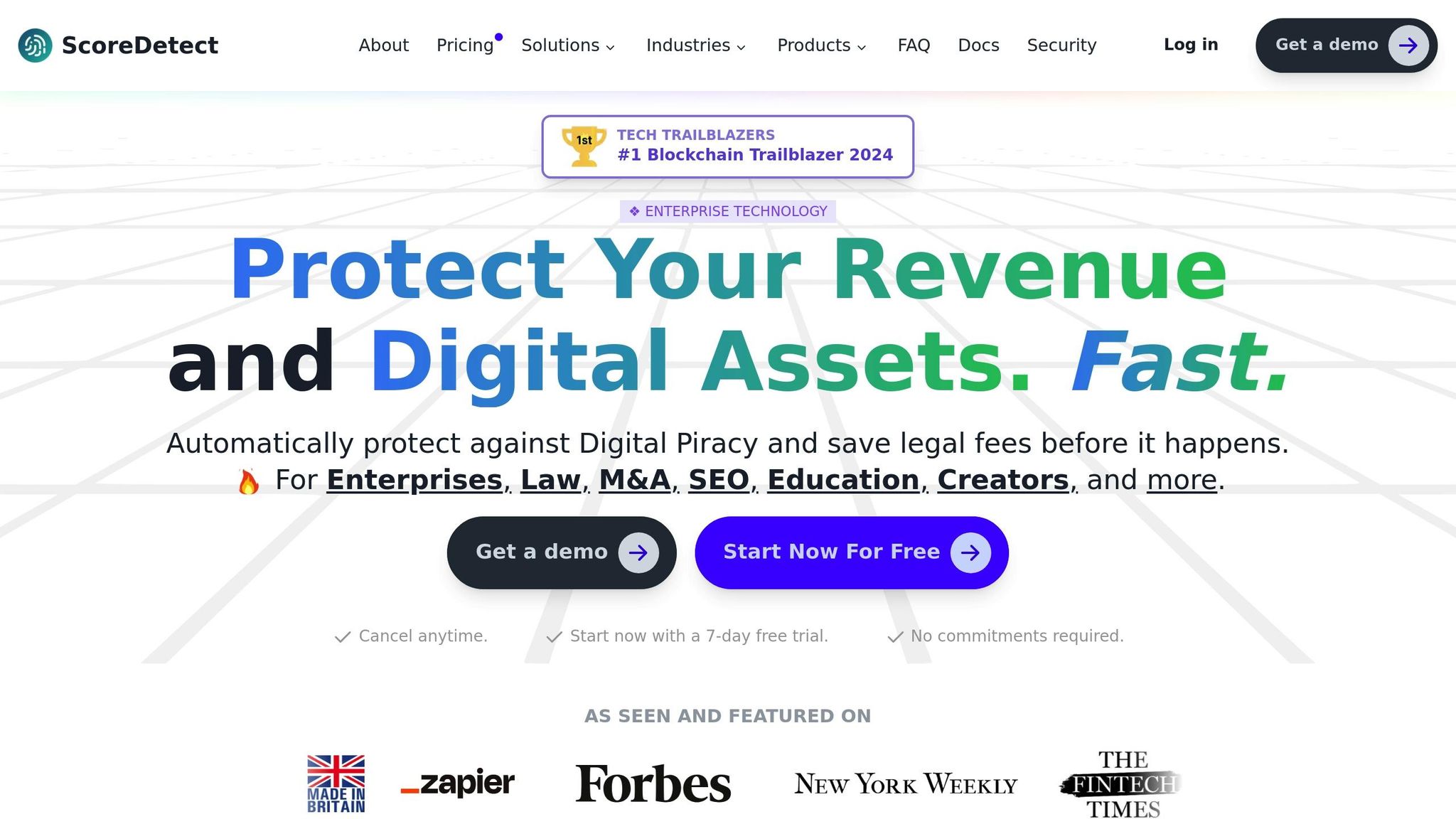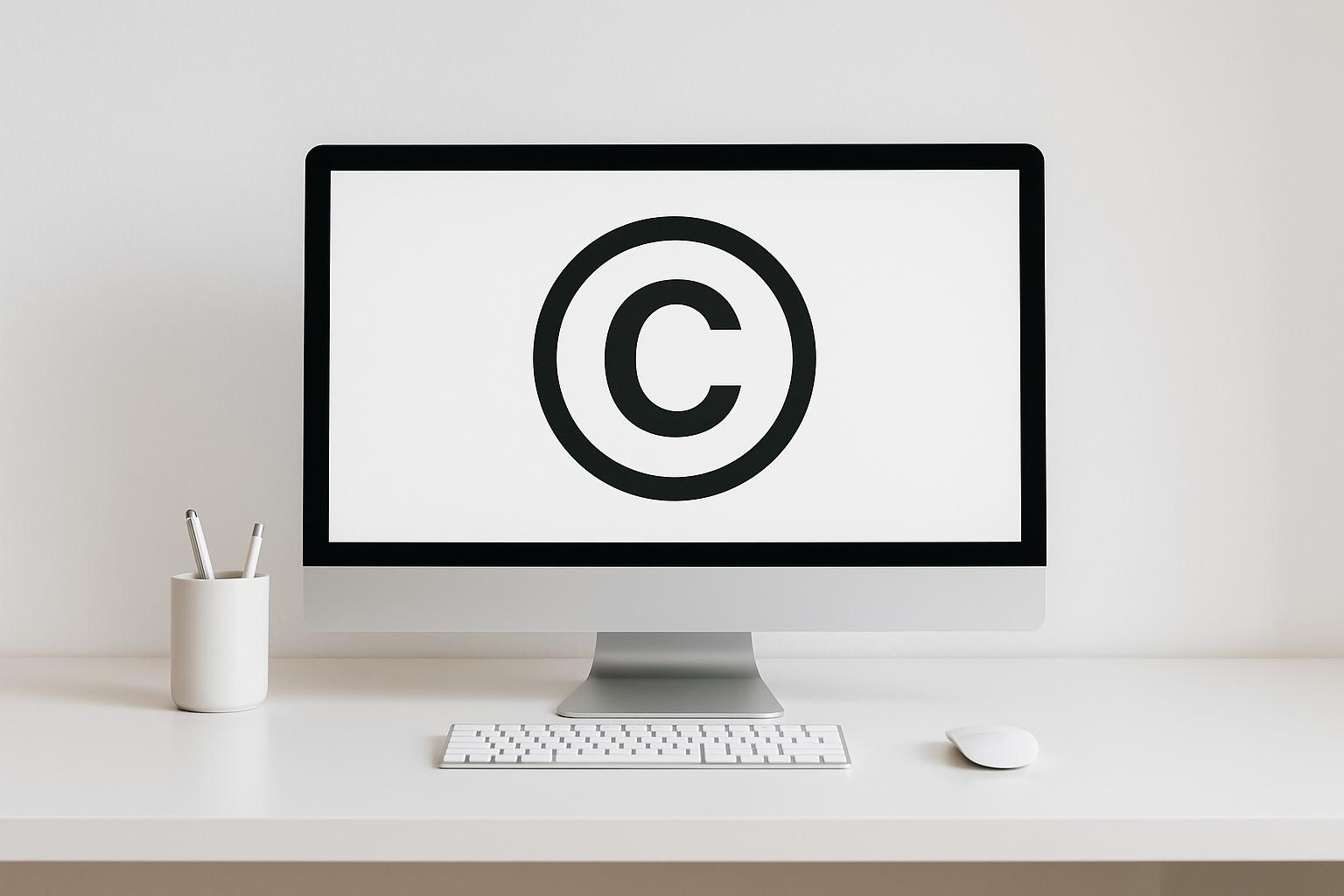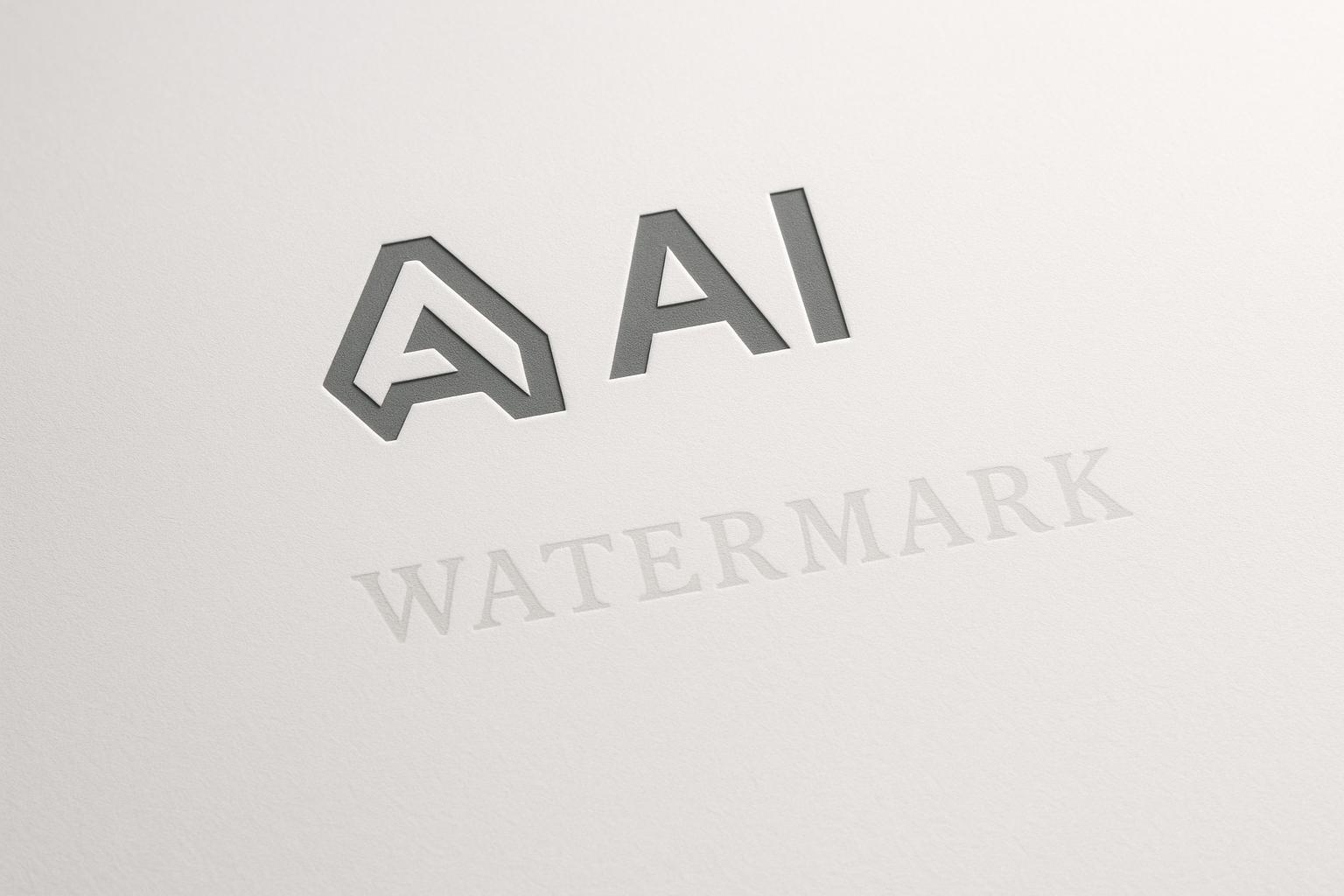AI watermarking embeds invisible markers into digital content, ensuring traceability and protecting ownership without affecting quality. Unlike older methods, this approach is more resistant to tampering and works across various formats like images, videos, audio, and text. It’s a critical tool for addressing challenges like misinformation, deepfakes, and unauthorized content use.
Key Points:
- What It Is: Invisible markers created using neural networks and machine learning.
- Why It’s Important: Differentiates AI-generated content, protects intellectual property, and combats misinformation.
- How It Works: Uses neural networks to embed watermarks and Bayesian methods for detection.
- Challenges: Varies by format – text is fragile, while images and videos face tampering risks.
- Practical Solution: Tools like ScoreDetect integrate watermarking with blockchain and automated enforcement.
AI watermarking is becoming indispensable for industries like media, healthcare, and finance, offering a secure way to verify and protect digital assets.
SynthID – Watermarking and identifying AI-generated text

How AI Watermarking Works
AI watermarking operates through two main processes: embedding watermarks into digital content and detecting them later. Together, these steps help ensure the security and traceability of digital assets.
Embedding Watermarks with Neural Networks
Neural networks, particularly encoder-decoder convolutional neural networks (CNNs) paired with GAN (generative adversarial network) discriminators, play a key role in embedding invisible watermarks. These systems strike a balance between keeping the watermark undetectable to the naked eye while ensuring it remains identifiable by algorithms [6].
The embedding process involves minimizing an objective function that compares the original and watermarked content, while also measuring the accuracy of the extracted watermark. This ensures the watermark is both subtle and detectable. Techniques like ReDMark, Zhong’s CNN-based method, and the HiDDeN scheme use adversarial training and iterative learning to strengthen watermark durability and invisibility [6]. One major advantage of deep learning-based methods is their ability to retrain continuously, adapting to new threats far more effectively than traditional approaches [6].
This sophisticated embedding process lays the groundwork for advanced detection techniques.
Detecting and Verifying Watermarks
Once embedded, specialized algorithms are used to detect and verify these invisible markers. Detection systems often rely on paired algorithms and Bayesian methods to evaluate the likelihood of a watermark’s presence, reducing false positives and negatives [5][7]. Bayesian detectors, for instance, calculate the probability that a watermark exists in the content by analyzing patterns and determining how likely it is that these patterns could appear naturally. A lower probability of natural occurrence increases confidence in the watermark detection [2].
A notable application of this technology comes from Dr. Yuheng Bu at the University of Florida. His research focuses on embedding invisible watermarks into portions of text generated by large language models. This approach maintains the overall quality of the text while ensuring the watermark remains detectable, even after modifications [8]. Private key mechanisms further enhance security by ensuring that only the original issuer can verify the watermark, even if the content undergoes editing [8].
For robust security, systems like SynthID Text require careful storage of each watermarking configuration to prevent unauthorized replication [7]. Even when content is edited, compressed, or altered, the probabilistic nature of AI-based detection ensures watermarks can still be identified. This makes AI watermarking a powerful tool for safeguarding digital content across a wide range of formats and platforms.
Multi-Format AI Watermarking Challenges
Applying AI watermarking to various types of content comes with its own set of technical difficulties. Whether it’s images, videos, audio, or text, each format has unique constraints and weaknesses that can impact the effectiveness of watermarking systems.
At the heart of these challenges is the need to balance three key factors: robustness (the ability of watermarks to withstand changes), fidelity (keeping alterations to the original content minimal), and capacity (how much information the watermark can carry) [10]. Achieving this balance becomes even trickier when dealing with multiple formats at the same time. Let’s dive into the specific challenges for visual, audio, and text-based content.
Watermarking Images and Videos
Images and videos allow for subtle, nearly invisible changes because of their high information density [9]. However, they’re not without vulnerabilities, especially when it comes to both accidental and deliberate attempts to tamper with watermarks.
One major threat to image watermarks is diffusion purification, a technique that can remove up to 92% of watermarks through advanced processing methods [11]. Similarly, model substitution attacks – where alternative AI models process the content – can bypass up to 68% of image watermarks [11].
Video watermarking adds another layer of complexity. Watermarks in videos must stay consistent across frames while surviving common processes like compression, format changes, and editing. The temporal nature of video content makes synchronization critical, leaving watermarks susceptible to desynchronization attacks, where alterations to individual frames disrupt detection [10].
Even simple actions like resaving images in different formats, cropping, or minor edits can interfere with watermark readability [10]. Malicious actors often exploit these weaknesses further by using small rotations or transcoding to deliberately undermine watermarking systems [10].
Watermarking Audio and Text
When it comes to audio and text, the challenges are just as distinct. For audio, the "analog hole" presents a significant problem. This occurs when digital audio is played through speakers and then re-recorded, effectively stripping away the digital watermarks [9]. Protecting audio in such scenarios is particularly tough.
Text watermarking, however, faces the steepest hurdles. Unlike visual or audio content, text has low information density, meaning even small changes are more noticeable to readers [9]. Because of its structured nature, altering text can easily affect its meaning or readability, creating a very narrow margin for embedding invisible markers.
False positives are another issue with text watermarking, with rates reported between 15-20% [11]. This means human-written content is often misclassified as AI-generated. While statistical methods can make watermark detection more effective, they also make text watermarks easier to remove [9].
Text watermarks are especially fragile under basic editing. For example, simple paraphrasing can erase or obscure watermarks in about 30% of cases [11]. Techniques like synonym replacement, sentence reordering, and rewording further undermine their integrity. Statistical text watermarks can be reverse-engineered and removed with a success rate of approximately 85% by analyzing patterns in AI-generated outputs [11].
"The watermarking algorithm itself can become a vehicle for novel and powerful attacks against the information ecosystem", says Chad Heitzenrater, Senior Information Scientist at RAND Corporation [10].
On top of these challenges, watermarking systems must operate efficiently in real-world scenarios. They need to integrate seamlessly into content creation pipelines without causing significant delays [9]. This becomes especially demanding when dealing with multiple content formats, each requiring different processing techniques and computational resources.
These challenges underscore the need for advanced solutions tailored to the unique properties and vulnerabilities of each media type. At the same time, these systems must uphold consistent security standards across all formats to ensure reliable content protection.
sbb-itb-738ac1e
ScoreDetect: A Practical AI Watermarking Solution

ScoreDetect steps up to tackle the challenges of digital content protection with a focused and effective approach. By combining AI watermarking, blockchain verification, and automated enforcement, it provides a well-rounded solution for safeguarding digital assets.
At its core, ScoreDetect uses invisible watermarking technology that works across a variety of content formats. Rather than relying on a single method, it layers multiple protective measures, creating a robust defense against the threats that often undermine traditional watermarking systems.
What sets ScoreDetect apart is its comprehensive design. It doesn’t just embed watermarks – it builds an entire ecosystem for content protection. This includes tools for detection, verification, and enforcement, ensuring organizations can address the growing risks of digital piracy and unauthorized use.
Key Features of ScoreDetect
ScoreDetect embeds invisible AI watermarks as digital signatures, ensuring both security and authenticity without compromising the quality of the content. This feature works seamlessly across images, videos, audio files, and documents, maintaining a smooth user experience.
The platform also integrates blockchain technology to record a content checksum, creating an unchangeable proof of ownership. When unauthorized use is detected, its automated system generates takedown notices, achieving a highly effective 96% success rate in removing infringing content.
To make content management easier, ScoreDetect connects with over 6,000 web apps through Zapier. For WordPress users, a dedicated plugin captures every published or updated article, generating blockchain-verified ownership records. At the same time, it boosts SEO by improving signals related to Google’s E-E-A-T (Experience, Expertise, Authoritativeness, Trustworthiness) framework.
These features address a wide range of content protection needs, making ScoreDetect a versatile tool for various industries.
Industries Using ScoreDetect
ScoreDetect’s ability to handle multiple content formats makes it a valuable asset across diverse industries. Media and entertainment companies rely on it to protect visual assets, safeguard brand integrity, and prevent unauthorized distribution.
Legal firms, academic institutions, and government agencies use the platform for tamper-proof ownership records and automated monitoring of research materials, official documents, and intellectual property.
Marketing, advertising, and SEO agencies benefit from the WordPress integration and blockchain timestamping to improve SEO rankings while ensuring content authenticity. Content creators also use ScoreDetect to claim ownership of their work and monitor its distribution online.
Healthcare organizations turn to ScoreDetect to protect sensitive medical images and documents, while finance and banking institutions safeguard proprietary research, reports, and marketing materials through continuous, automated monitoring.
With enterprise-level features like 24/7 monitoring, dedicated support, and white-label options, ScoreDetect caters to the complex needs of large organizations. Its widespread adoption highlights the growing demand for reliable AI watermarking tools that can adapt to a variety of content protection challenges.
Conclusion
AI watermarking is reshaping how digital content is protected. With neural networks advancing rapidly, embedding invisible, durable watermarks into images, videos, audio, and text has shifted from being a theoretical concept to a critical necessity for businesses.
The process of watermarking across multiple formats comes with its own set of challenges. Balancing invisibility with durability and managing the heavy computational load of neural network processing demands tailored solutions that can handle various content types and distribution methods. As computer and communication engineer Natasha Al-Khatib explains:
"AI watermarking holds immense potential to build trust and transparency. By enabling the identification of AI-generated content, it can combat misinformation, protect intellectual property, and promote ethical AI use." [3]
The urgency of this technology is clear. Studies suggest that adopting watermarking on a large scale could cut the spread of AI-generated misinformation by up to 40% in the coming years [4]. This statistic highlights why industries like media, entertainment, healthcare, and finance are increasingly adopting AI watermarking as part of their content protection strategies.
One standout example is ScoreDetect, whose approach integrates invisible AI watermarks with blockchain verification and automated enforcement. With a 96% success rate in takedowns and compatibility with over 6,000 web applications, they demonstrate the level of comprehensive protection businesses need today.
To implement AI watermarking effectively, companies should start by embedding these protection measures into their content creation and distribution workflows [1]. This involves assessing current pipelines, pinpointing at-risk assets, and setting up monitoring systems to detect unauthorized usage across platforms and formats.
As technology evolves, businesses must stay ahead of the curve. The future of digital content protection will depend on creating standardized, interoperable watermarking systems that work seamlessly across platforms while balancing security with user experience. By acting now, organizations can safeguard their intellectual property and strengthen trust with their audiences in an ever-changing digital landscape.
FAQs
How is AI watermarking more secure and functional compared to traditional methods?
AI watermarking works by embedding hidden, unique markers directly into digital content. These markers are invisible to the naked eye, making them much harder to detect, alter, or remove compared to traditional visible watermarks. This approach provides stronger security and better protection for digital assets.
Unlike older methods that use external or visible marks, AI watermarking integrates directly into various types of content, such as images, videos, and documents. Its ability to blend seamlessly ensures that the content’s quality and user experience remain unaffected while still offering robust protection.
What challenges arise when using AI watermarking for text, and how can they be addressed?
AI watermarking for text comes with its own set of hurdles. For instance, content can be easily rephrased to sidestep watermarks, editing or compressing text can compromise the watermark’s integrity, and the rapid advancement of AI often outpaces existing watermarking techniques.
To tackle these issues, it’s crucial to focus on making watermarks more durable, using detection methods that are tougher to bypass, and creating algorithms that can keep up with AI’s progress. By emphasizing flexibility and resilience, AI watermarking can provide strong protection for text-based content.
How can industries like healthcare and finance use AI watermarking to protect their digital content?
Industries like healthcare and finance stand to gain a lot from AI watermarking, especially when it comes to securing and verifying their digital content. By embedding invisible, tamper-resistant watermarks, organizations can confirm the source of sensitive information, block unauthorized access, and discourage misuse.
In healthcare, this technology plays a key role in keeping patient records and research data confidential. Meanwhile, in finance, it helps shield proprietary data and financial reports from being compromised. These safeguards not only enhance data privacy but also foster trust among stakeholders by ensuring critical information stays protected from breaches or improper distribution.

